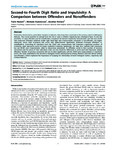Second-to-fourth digit ratio and impulsivity: a comparison between offenders and nonoffenders.
| dc.contributor.author | Hanoch, Y | en |
| dc.contributor.author | Gummerum, M | en |
| dc.contributor.author | Rolison, J | en |
| dc.date.accessioned | 2017-10-05T10:14:58Z | |
| dc.date.available | 2017-10-05T10:14:58Z | |
| dc.date.issued | 2012 | en |
| dc.identifier.uri | http://hdl.handle.net/10026.1/10010 | |
| dc.description.abstract |
Personality characteristics, particularly impulsive tendencies, have long been conceived as the primary culprit in delinquent behavior. One crucial question to emerge from this line of work is whether impulsivity has a biological basis. To test this possibility, 44 male offenders and 46 nonoffenders completed the Eysenck Impulsivity Questionnaire, and had their 2D∶4D ratio measured. Offenders exhibited smaller right hand digit ratio measurements compared to non-offenders, but higher impulsivity scores. Both impulsivity and 2D∶4D ratio measurements significantly predicted criminality (offenders vs. nonoffenders). Controlling for education level, the 2D∶4D ratio measurements had remained a significant predictor of criminality, while impulsivity scores no longer predicted criminality significantly. Our data, thus, indicates that impulsivity but not 2D∶4D ratio measurements relate to educational attainment. As offenders varied in their number of previous convictions and the nature of their individual crimes, we also tested for differences in 2D∶4D ratio and impulsivity among offenders. Number of previous convictions did not correlate significantly with the 2D∶4D ratio measurements or impulsivity scores. Our study established a link between a biological marker and impulsivity among offenders (and lack thereof among non-offenders), which emphasise the importance of studying the relationship between biological markers, impulsivity and criminal behavior. | en |
| dc.format.extent | e47140 - ? | en |
| dc.language | eng | en |
| dc.language.iso | eng | en |
| dc.subject | Adult | en |
| dc.subject | Criminals | en |
| dc.subject | Fingers | en |
| dc.subject | Humans | en |
| dc.subject | Impulsive Behavior | en |
| dc.subject | Male | en |
| dc.subject | Middle Aged | en |
| dc.subject | Young Adult | en |
| dc.title | Second-to-fourth digit ratio and impulsivity: a comparison between offenders and nonoffenders. | en |
| dc.type | Journal Article | |
| plymouth.author-url | https://www.ncbi.nlm.nih.gov/pubmed/23082144 | en |
| plymouth.issue | 10 | en |
| plymouth.volume | 7 | en |
| plymouth.publication-status | Published | en |
| plymouth.journal | PLoS One | en |
| dc.identifier.doi | 10.1371/journal.pone.0047140 | en |
| plymouth.organisational-group | /Plymouth | |
| plymouth.organisational-group | /Plymouth/REF 2021 Researchers by UoA | |
| plymouth.organisational-group | /Plymouth/REF 2021 Researchers by UoA/UoA04 Psychology, Psychiatry and Neuroscience | |
| plymouth.organisational-group | /Plymouth/Research Groups | |
| plymouth.organisational-group | /Plymouth/Research Groups/Centre for Brain, Cognition and Behaviour (CBCB) | |
| plymouth.organisational-group | /Plymouth/Research Groups/Centre for Brain, Cognition and Behaviour (CBCB)/Behaviour | |
| plymouth.organisational-group | /Plymouth/Research Groups/Centre for Brain, Cognition and Behaviour (CBCB)/Cognition | |
| dc.publisher.place | United States | en |
| dcterms.dateAccepted | 2012-09-10 | en |
| dc.identifier.eissn | 1932-6203 | en |
| dc.rights.embargoperiod | Not known | en |
| rioxxterms.versionofrecord | 10.1371/journal.pone.0047140 | en |
| rioxxterms.licenseref.uri | http://www.rioxx.net/licenses/all-rights-reserved | en |
| rioxxterms.licenseref.startdate | 2012 | en |
| rioxxterms.type | Journal Article/Review | en |


